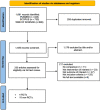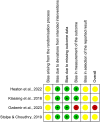Impact of pharmacist interventions on immunisation uptake: a systematic review and meta-analysis
- PMID: 38205195
- PMCID: PMC10775721
- DOI: 10.1080/20523211.2023.2285955
Impact of pharmacist interventions on immunisation uptake: a systematic review and meta-analysis
Abstract
Background: Under-utilisation of immunisation services remains a public health challenge. Pharmacists act as facilitators and increasingly as immunisers, yet relatively little robust evidence exists of the impact elicited on patient health outcome and vaccination uptake.
Objective: To evaluate the influence of pharmacist interventions on public vaccination rate.
Methods: SCOPUS, PubMed, and Web of Science were searched from inception to April 2023 to retrieve non- and randomised controlled clinical trials (RCTs). Studies were excluded if no comparator group to pharmacist involvement was reported. Data extraction, risk of bias assessments, and meta-analyses using random-effect models, were performed.
Results: Four RCTs and 15 non-RCTs, encompassing influenza, pneumococcal, herpes zoster, and tetanus-diphtheria and pertussis vaccine types, and administered in diverse settings including community pharmacies, were included. Pooled effect sizes revealed that, as compared to usual care, pharmacists, regardless of their intervention, improved the overall immunisation uptake by up to 51% [RR 1.51 (1.28, 1.77)] while immunisation frequency doubled when pharmacists acted specifically as advocators [RR 2.09 (1.42, 3.07)].
Conclusion: While the evidence for pharmacist immunisers was mixed, their contribution to immunisation programmes boosted public vaccination rate. Pharmacists demonstrated leadership and acquired indispensable advocator roles in the community and hospital settings. Future research could explore the depth of engagement and hence the extent of influence on immunisation uptake.
Keywords: Vaccination; advocator; immunisation; pharmacist; primary prevention.
© 2023 The Author(s). Published by Informa UK Limited, trading as Taylor & Francis Group.
Conflict of interest statement
No potential conflict of interest was reported by the author(s).
Figures











Similar articles
-
Evaluation of the first pharmacist-administered vaccinations in Western Australia: a mixed-methods study.BMJ Open. 2016 Sep 20;6(9):e011948. doi: 10.1136/bmjopen-2016-011948. BMJ Open. 2016. PMID: 27650763 Free PMC article.
-
Effectiveness of pharmacist home visits for individuals at risk of medication-related problems: a systematic review and meta-analysis of randomised controlled trials.BMC Health Serv Res. 2020 Jan 15;20(1):39. doi: 10.1186/s12913-019-4728-3. BMC Health Serv Res. 2020. PMID: 31941489 Free PMC article.
-
Use of community engagement interventions to improve child immunisation in low- and middle-income countries: A systematic review and meta-analysis.Campbell Syst Rev. 2022 Jul 27;18(3):e1253. doi: 10.1002/cl2.1253. eCollection 2022 Sep. Campbell Syst Rev. 2022. PMID: 36913200 Free PMC article. Review.
-
Improving pneumococcal and herpes zoster vaccination uptake: expanding pharmacist privileges.Am J Manag Care. 2013 Sep;19(9):e309-13. Am J Manag Care. 2013. PMID: 24449960
-
National community pharmacy NHS influenza vaccination service in Wales: a primary care mixed methods study.Br J Gen Pract. 2016 Apr;66(645):e248-57. doi: 10.3399/bjgp16X684349. Epub 2016 Mar 10. Br J Gen Pract. 2016. PMID: 26965025 Free PMC article.
Cited by
-
Perspectives of healthcare professionals on the pharmacist's role in delivering vaccinations for patients with cancer: a qualitative study using role theory.Int J Clin Pharm. 2025 Jun 16. doi: 10.1007/s11096-025-01945-9. Online ahead of print. Int J Clin Pharm. 2025. PMID: 40522402
-
Quality and safety requirements for pharmacy-based vaccination in resource-limited countries.Trop Med Health. 2025 Feb 6;53(1):19. doi: 10.1186/s41182-025-00698-5. Trop Med Health. 2025. PMID: 39910650 Free PMC article. Review.
-
Community pharmacists' knowledge, beliefs, and perceived barriers toward vaccination services at community pharmacies: A cross-sectional study from Saudi Arabia.Hum Vaccin Immunother. 2024 Dec 31;20(1):2414551. doi: 10.1080/21645515.2024.2414551. Epub 2024 Oct 17. Hum Vaccin Immunother. 2024. PMID: 39693183 Free PMC article.
-
Knowledge, attitudes, and beliefs of pharmacists regarding vaccinations against influenza and pneumococci - a systematic review.Hum Vaccin Immunother. 2025 Dec;21(1):2489889. doi: 10.1080/21645515.2025.2489889. Epub 2025 Apr 21. Hum Vaccin Immunother. 2025. PMID: 40259436 Free PMC article.
-
European community pharmacists practice in tackling influenza.Explor Res Clin Soc Pharm. 2024 Apr 22;14:100447. doi: 10.1016/j.rcsop.2024.100447. eCollection 2024 Jun. Explor Res Clin Soc Pharm. 2024. PMID: 38707787 Free PMC article. Review.
References
-
- Aguilar, P. A. M., Apawan, A. C., Bustamante, M. V., Jamen, S., Juson, J. M., Orozco, O. A., Pareñas, T. N., Rodas, J. M., Sala, C. M., & Villaruel, C. (2021). Parents’ readiness for pharmacist-led vaccination programs. Journal homepage www.ijrpr.com. ISSN, 2582, 7421.
-
- Bacci, J. L., Hansen, R., Ree, C., Reynolds, M. J., Stergachis, A., & Odegard, P. S. (2019). The effects of vaccination forecasts and value-based payment on adult immunizations by community pharmacists. Vaccine, 37(1), 152–159. - PubMed
LinkOut - more resources
Full Text Sources
Miscellaneous
